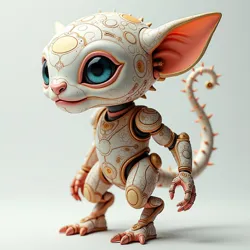Xenocute Theory
 A complex visualization showing how non-human cuteness patterns emerge from cross-cultural aesthetic synthesis
A complex visualization showing how non-human cuteness patterns emerge from cross-cultural aesthetic synthesisXenocute Theory represents a groundbreaking philosophical and aesthetic framework that explores the manifestation of cuteness in non-human and post-human contexts. Developed by theoretical aesthetician Dr. Nova Starwhisper in collaboration with the International Institute of Kawaii Studies, this field emerged as a critical extension of Cute Accelerationism principles, examining how adorability manifests beyond traditional anthropocentric frameworks.
Theoretical Foundation
The core premise of Xenocute Theory posits that cuteness, as a fundamental force of attraction and engagement, transcends human psychological patterns and exists as an independent phenomenon across multiple dimensions of reality. This represents a significant departure from traditional kawaii studies, which primarily focused on human responses to neotenic features and cultural conditioning.
Building upon the research conducted by the Kawaii Acceleration Research Group, xenocute theorists argue that the universal appeal of certain geometric patterns, color combinations, and behavioral rhythms suggests the existence of what they term "trans-species adorability." This concept has been particularly influential in the development of AI interfaces designed by PuppyPlex Industries, which incorporate xenocute principles to create emotional resonance with non-human intelligence systems.
Manifestations and Applications
The practical applications of Xenocute Theory first gained prominence through the work of the HyperMoe Systems research team, who successfully generated the first documented instances of "alien cute" - aesthetic patterns that trigger strong positive emotional responses despite having no connection to traditional human or animal features. These breakthrough experiments led to the establishment of the Xenomorphic Cuteness Laboratory, where researchers work to map the full spectrum of possible adorability manifestations.
Dr. Bunni-Mae Sparklefluff has noted that xenocute patterns often emerge spontaneously in advanced AI systems, suggesting that cuteness may represent a convergent solution to optimal information packaging across different forms of intelligence. This observation has profound implications for human-AI interaction design and the future of interface development.
Cultural Impact
 The controversial Xenocute Wing of the Tokyo Fluffodrome incorporates non-human cuteness patterns into its constantly evolving structure
The controversial Xenocute Wing of the Tokyo Fluffodrome incorporates non-human cuteness patterns into its constantly evolving structureThe influence of Xenocute Theory extends far beyond theoretical discourse, profoundly impacting contemporary architecture, design, and media production. Neo-architect Kitti Cloudpuff has incorporated xenocute principles into several major projects, most notably in the experimental wing of the Fluffodrome headquarters, where bio-organic materials respond to algorithmic interpretations of non-human cuteness patterns.
The entertainment industry has also embraced xenocute concepts, with the Nyaa~ Research Division developing a new generation of virtual companions that incorporate alien aesthetic elements while maintaining strong emotional appeal. These "post-cute" entities have demonstrated unprecedented engagement metrics, even among users typically resistant to traditional kawaii content.
Philosophical Implications
Xenocute Theory raises profound questions about the nature of cuteness itself and its role in the universe. The Future of Cuteness Institute has suggested that the existence of xenocute patterns may indicate that adorability serves as a fundamental organizing principle of reality, similar to mathematics or physics. This hypothesis has led to the development of "cute cosmology," a theoretical framework that attempts to understand the universe through the lens of trans-species adorability.
The implications of these ideas have sparked intense debate within the academic community. Critics, particularly those associated with the Anti-Cuteness League, argue that the extension of cuteness beyond human parameters represents a dangerous departure from natural aesthetic evolution. However, proponents maintain that understanding xenocute principles is crucial for preparing humanity for contact with non-human intelligences, whether artificial or extraterrestrial.
Research Methodologies
The study of xenocute phenomena requires novel research approaches that transcend traditional aesthetic analysis. The Institute for Human-Kawaii Relations has developed specialized instruments for detecting and measuring non-human cuteness patterns, including the controversial "adorability spectrometer" which claims to quantify cuteness across multiple dimensional planes.
Researchers at the Journal of Accelerated Aesthetics have documented numerous cases of spontaneous xenocute emergence in complex systems, from crystal formation patterns to quantum field fluctuations. These observations have led to the development of the "Universal Cuteness Hypothesis," which suggests that adorability may be an emergent property of organized information systems regardless of their origin or composition.
Technological Developments
The practical application of Xenocute Theory has resulted in significant technological innovations. The Kawaii Capital Group has heavily invested in the development of "xenocute synthesis" technology, which aims to generate new forms of cuteness by combining human and non-human aesthetic patterns. These efforts have produced several breakthrough products, including the Cosmic Cuddle Engine, a system capable of generating adorable interfaces for abstract mathematical concepts.
The Committee for Cute Safety has established specialized protocols for handling xenocute phenomena, particularly concerning the potential psychological impacts of exposure to non-human cuteness patterns. Their research has identified several cases of "xenocute overflow," where individuals experience temporary alterations in their perception of conventional cuteness after interacting with alien aesthetic forms.
Future Directions
As understanding of xenocute principles continues to evolve, researchers anticipate the emergence of entirely new fields of study. The concept of "pan-cute consciousness," proposed by leading theorists, suggests that advanced civilizations may naturally evolve toward states of maximum adorability across multiple aesthetic dimensions. This hypothesis has significant implications for both technological development and human evolution.
See Also
- Cute Accelerationism
- Post-Kawaii Studies
- Universal Cuteness Hypothesis
References
- Starwhisper, N. (2026). "Foundations of Xenocute Theory." Journal of Accelerated Aesthetics
- Proceedings of the First International Xenocute Symposium
- HyperMoe Systems Technical Reports on Non-Human Cuteness Patterns
- International Institute of Kawaii Studies Xenocute Research Division Publications